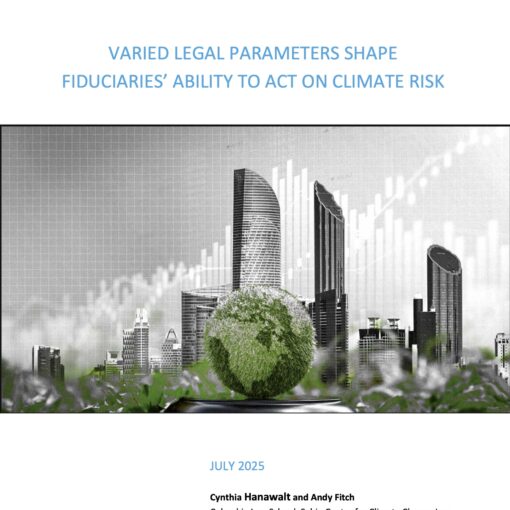 Though it has been largely ignored by the healthcare industry thus far, and unmentioned by Department of Health and Human Services (HHS), the Securities and Exchange Commission’s (SEC) climate disclosure rule may prove to be one of the most consequential healthcare regulations in US history.
Though it has been largely ignored by the healthcare industry thus far, and unmentioned by Department of Health and Human Services (HHS), the Securities and Exchange Commission’s (SEC) climate disclosure rule may prove to be one of the most consequential healthcare regulations in US history.
Healthcare investors are particularly interested in healthcare’s climate-related financial risk exposure due to the sheer size of the industry. Market capitalization, or the total value of industry stock, equals approximately $6.7 trillion, an amount larger than the GDP of every country except China and the US. With the SEC’s new climate rule, publicly traded companies will be required to disclose greenhouse gas (GHG) emissions information and climate-related financial risks for the purpose of informing investor decisions. These disclosures will likely reveal several healthcare industry challenges, including the fact the industry is as capital intensive as it is carbon intensive.
The SEC Rule
On March 6, 2024, the SEC issued its final climate disclosure rule formally titled, “The Enhancement and Standardization of Climate-Related Disclosures for Investors.” The Sabin Center published a blog series in March 2024, which details the requirements of the rule and considers the future of climate disclosure and how the SEC’s rule interacts with other regulatory regimes.
The SEC has voluntarily stayed the rule pending resolution of several petitions challenging the requirements in federal court. Final resolution of this litigation is not anticipated before next year, which may delay compliance deadlines.
Healthcare’s Climate Risk Exposure
Possibly more than any other industry, healthcare is vulnerable to underreported climate-related financial risks that will be exposed by the SEC’s rule. Several reasons explain this: the healthcare industry is highly leveraged; particularly exposed to climate-related financial risks; and, remains a major contributor to GHG emissions.
The healthcare industry heavily depends on debt financing. Because of its capital intensity – the result of significant investments in bricks and mortar, high-tech equipment and a substantial reliance on human capital – along with healthcare’s infamous fragmentation and waste, financing requirements are met by a constellation of actors. In addition to federal and state departments and agencies, commercial and investment banks and private financing all play a role, including venture capital and private equity (PE), which has invested approximately $1 trillion via more than 8,000 healthcare acquisitions in the US over the past decade. The significant role of investors has long raised financialization concerns, meaning the industry has become increasingly dominated by financial actors that define healthcare as a common tradable market commodity. “The American medical system,” Dr. Elisabeth Rosenthal bluntly stated in her 2017 critique, “attends more or less single-mindedly to its own profits.” An increasing emphasis on profit-taking also increases the demand among investors for climate-related financial risk disclosure.
Since the SEC rule applies to publicly-traded companies only, some health care institutions won’t be covered. Non-profit hospitals, for example, will not be regulated. This distinction is likely moot. Non-profit hospitals – that suffer a poorer payer mix, treat higher acuity patients, are required to serve a charitable purpose and cannot raise capital via stock sales – have comparatively lower operating margins and their outstanding debt has dramatically increased over the past few decades. To raise capital, they are forced to turn to the tax-exempt bond market. And credit agencies like Moody’s weigh numerous factors to rate their bonds, including climate-related risk.
Given healthcare’s necessarily broad geographic footprint, climate risk to its physical assets is particularly relevant. Last year’s climate-charged disasters caused insured property losses totaling $79 billion. A single California climate-charged wildfire season, 2017-2018, wiped out an estimated 25 years of insurance company profits. As a result, the property insurance market has experienced significant premium increases. Since 2022, 31 states have seen rates rise by double digits. Property insurers have also gutted coverage and started blue-lining where carriers exit the market, most noteworthy in Florida and Louisiana. Because property loans are predicated on property insurance, healthcare’s enormous footprint and market value leave it particularly threatened by rapidly rising property insurance premiums. Ironically, an industry nearly entirely afforded by insurance premiums, is increasingly threatened by an uninsurable future. Think: stranded assets.
Healthcare’s climate risk is further underscored by its outsized carbon footprint. The industry is accountable for a massive amount of annual GHG emissions, estimated at over 550 million metric tons (Mt) of carbon dioxide equivalent, the equivalent of burning 550 billion pounds of coal. This equals roughly 9% of total annual US and 4.5% of total global GHG emissions, with an equal percent of toxic air pollution. If US healthcare was its own country, it would rank 15th worldwide in emissions.
Healthcare’s emissions contributions are exacerbated by the fact the industry is highly energy inefficient. Hospitals, healthcare’s largest energy consumers, are responsible for approximately 35% of total industry GHG emissions. There are over 6,000 hospitals, and roughly half of these hospitals participate in the EPA’s Energy Star program. Of these, only 37 were certified for energy efficiency in 2023. Research published in 2019 found that American hospitals consume energy at more than twice the rate of European hospitals, with no comparable quality advantage.
The Healthcare Industry’s Failure to Mitigate its Climate Risk
The healthcare industry largely does not publicly disclose its GHG emissions. The one mention of healthcare in the SEC final rule noted that among Russell 1000 Index companies, a significantly lower percentage of healthcare companies annually publish sustainability reports compared to other industries including energy, finance, information technology, real estate and electrical utilities. Research published in 2022 similarly concluded, “as Wall Street moves quickly ahead with ESG, the U.S. health care delivery sector lags far behind in terms of sustainability management and disclosure.”
Healthcare professional and trade associations are not galvanizing the industry to report, much less mitigate, GHG emissions. For example, the American Hospital Association makes no mention of the climate crisis in its 2024 Advocacy Agenda, nor is it discussed in the American Medical Association’s Advocacy Efforts. Climate is also not a policy issue for the Pharmaceutical Research and Manufacturers of America. And there also has been little effort within the healthcare industry to divest from fossil fuels. A report published this past February concluded, “antithetically, the health sector is heavily connected to the fossil fuel industry through its investments, pensions, and retirement funds.”
There is an obvious contradiction in healthcare’s disregard of its climate impact. In testimony before the House Ways and Means Committee in 2022, Yale Anesthesiologist Dr. Jodi Sherman argued, “climate change . . . is now recognized as the greatest global public health threat of the 21st century,” however, “ironically, healthcare is a major polluting industry.” Nevertheless, “the vast majority of U.S. health care organizations,” she found, remain uncommitted to timely action.” Sherman also acknowledged that “each time I take care of a patient . . . I also suffer moral injury knowing I am also causing harm to someone else through health care pollution.” A recent survey of health care executives and clinical leaders found that only 24% of US respondents thought that their organizations “had taken steps to lessen its impact on climate change” and only 8% thought their “organization measures its GHG emissions/carbon footprint.”
Federal healthcare regulators have also failed to step up. HHS has not promulgated a single regulatory rule to mitigate the industry’s GHG emissions despite the fact that, as the largest payer of US healthcare, the federal government’s exposure to healthcare’s climate-related financial risk is second to none. And the federal government’s climate-related financial risk is compounded by the fact that industry emissions contribute to innumerable and unrelenting climate-related health harms that disproportionately impact 150 million HHS Medicare and Medicaid beneficiaries.
In a January 2021 White House Executive Order (EO) in which the Biden administration committed to a “government-wide” approach to “tackle” the climate crisis, HHS was directed to create an Office of Climate Change and Health Equity (OCCHE). In launching the OCCHE in August 2021, HHS Secretary Xavier Becerra promised to use all the “tools in the toolbox” to mitigate healthcare’s GHG emissions. Unfortunately, OCCHE remains unfunded, and its efforts have been largely limited to pursing educational efforts related to Inflation Reduction Act energy security tax credits and cochairing an “action collaborative” with the National Academy of Medicine (NAM) to decarbonize healthcare that has also limited its efforts to educational outreach.
There is plenty HHS could be doing to address climate-related risks in healthcare. HHS Secretary Xavier Becerra could have published an interim final rule requiring hospitals to publicly disclose their GHG emissions by exploiting the performance improvement provision within Medicare and Medicaid Conditions of Participation rules. The Secretary also could have declared the climate crisis a public health emergency under the Public Health Services Act. HHS’ strategy has instead been limited to promising to “mitigate the impacts of environmental factors, including climate change” and to “ensure the security and climate resiliency of HHS facilities.” Secretary Becerra did announce in April 2022 a climate pledge program where healthcare organizations could voluntarily commit to meet the Biden administration’s goal of reducing GHG emissions by 50% by 2030. Measuring the success of this initiative is impossible because pledgees are not required to use accepted sustainability accounting practices, moreover the Greenhouse Gas Protocol, to verify progress.
Conclusion
The SEC is of course not a healthcare regulator. Its role is to ensure investors have sufficient information about financial risks to make informed decisions. In its final rule, the SEC stated it “remains agnostic about whether or how registrants consider or mange climate related risks.” Still, transparency surrounding healthcare’s climate-related financial risk exposure cannot come soon enough. Because of healthcare’s heavy reliance on financing, its outsized carbon footprint, its failure to mitigate its GHG emissions and grapple with climate-related financial risk, the SEC’s rule will likely have particular impact on how investors allocate healthcare investment capital. The SEC rule offers the real possibility of improving the health of industry along with our own.






